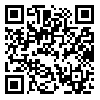1. Thomas NK. Residen Burnout. JAMA 2004; 292 (23):2880-9. [
DOI:10.1001/jama.292.23.2880]
2. McCray LW, Cronholm PF, Bogner HR, Gallo JJ, Neill RA.Resident Physician Burnout :Is There Hope? Fam-Med 2008; 40 (9): 628-632.
3. Khazaei T, Khazaei T, Sharifzade Gh. Professional burnout & predisposing factor. J-Birjand Univ Med Sci 2006; 13 (1): 56-62.
4. Businger A, Stefenelli U, Guller U. Prevalence of Burnout Among Surgical Residents & Switzerland. Arch Surg 2010; 145 (10): 1013-1016. [
DOI:10.1001/archsurg.2010.188]
5. Prins JT, Gazendman-Donfrio SM, Tubben BJ ,Van der Heijden FM, Van de Wiel HB, Hoekstra-Weebers JE. Burnout in medical residents. Med Educ 2007: 41: 788-800. [
DOI:10.1111/j.1365-2923.2007.02797.x]
6. Vasse RM, Nijhuis FJ, Kok G. Association between work stress, alcohol consumption and sickness abstance. Addiction.1998; 1: 231-241. [
DOI:10.1046/j.1360-0443.1998.9322317.x]
7. Sonnetage S, Brodbeck FC, Heinbokel T, Stolte W. Stressor-burnout relationship in software development teams. Occup & Organ Psysi J1994; 67(4): 327-341. [
DOI:10.1111/j.2044-8325.1994.tb00571.x]
8. Lockley SW, Cronin JW, Evans EE, Cade BE, Lee CJ, Landriga CP ,et al. Effect of reducing interns weekly work hours on sleep & attentional failures.NEJM 2004; 351: 1829: 1837. [
DOI:10.1056/NEJMoa041404]
9. Stecker T.Well_Being in an academic environmrnt. Med Educ 2004; 38 (5): 465-478. [
DOI:10.1046/j.1365-2929.2004.01812.x]
10. Moffat K, McConachie A, Ross S, Morrison J. First year medical student stress & coping in a problem_based learning medical curriculum. Med Educ2004; 38 (5): 482-491. [
DOI:10.1046/j.1365-2929.2004.01814.x]
11. Finkelstein C, Brownstein A, Scott C, Lan YL. Anxiety & stress reduction in medical education. Acad Med 2007; 41: 258-264. [
DOI:10.1111/j.1365-2929.2007.02685.x]
12. Levey RE. Sourse of stress for residents & recommendations for programs to assist them. Acad Med 2001; 76 (2): 142-50. [
DOI:10.1097/00001888-200102000-00010]
13. Campbell J , Prochazka AV, Yamashita T, Gopal R .Predictor of persistent burnout in internal medicine residents. Acad Med 2010; 85 (10):1630-4. [
DOI:10.1097/ACM.0b013e3181f0c4e7]
14. Garza JA, Schneider KM, Promecene P, Monga M. Burnout in residency: a statewide study. South Med J. 2004; 97 (12): 1171-3. [
DOI:10.1097/01.SMJ.0000129926.66568.10]
15. Shanafelt TD, Bradly KA, Wipf JE, Back AL. Burnout and self-reported patient care in an internal medicine residency program. Ann Intern Med.2002; 136(5):358-367. [
DOI:10.7326/0003-4819-136-5-200203050-00008]
16. Biaggi P, Peter S, Ulich E. Stressors, emotional exhaustion and aversion to patients in residents and chief residents. What can be done? Swiss Med Week 2003 ;133 (23-24): 339-46.
17. Martini S, Arfken C, Chrchill A , Balon R. Burnout comparison among residents in different medical specialities. Acad Psychiatric 2004; 28 (3): 240-2. [
DOI:10.1176/appi.ap.28.3.240]
18. Fahrenkopf AM, Sectish TC, Barger LK, et al. Rates of medication errors among depressed & burnout residents: prospective cohort study. BMJ 2008; 336 (7642): 488-491. [
DOI:10.1136/bmj.39469.763218.BE]
19. Castelo-Branco C, Figueras F,Eixarch E, Quereda F, Cancelo MJ, González S, Balasch J..Stress symtoms & burnout in obstetric gynecologic residents .B JOG.2007;114 (5): 94-98. [
DOI:10.1111/j.1471-0528.2006.01155.x]
20. Gelfand DV, Podnos YD.Eefects of 82 hours workweek on residents burnout. Arc Surg 2004;139 (9): 933-938. [
DOI:10.1001/archsurg.139.9.933]
21. Waldman S, Deiz H , Arazi HC, Linetzky B, Guinjoan S, Grancelli H. Burnout perceived stress & depression among cardiology residents in Argentina. Acad Psychiatry 2009; 33 (4):296-301. [
DOI:10.1176/appi.ap.33.4.296]
22. Barrach RL,Miller LS, Sotile WM, Sotile MO, Rubash HE. Effect of duty hour standard on burn out among Orthopedic surgery resident. Clinical orthop Related Res 2006; 449: 134-137. [
DOI:10.1097/01.blo.0000224030.78108.58]
23. Dyrbye LN, Thomas MR, Huntington JL, Lawson KL, Novotny PJ, Sloan JA, et al. Personal life vents and medical student burnout: a multicenter study. Acad Med 2006; 81 (4): 374-84. [
DOI:10.1097/00001888-200604000-00010]
24. Akbari R, Ghafar Samar1 R, Kiany G R, Eghtesadi A R. [Factorial Validity and Psychometric Properties of Maslach Burnout Inventory -The Persian Version]. Knowledge & Health 2011; 6 (3): 1-8. [Persian]
25. Carlotto MS, Palazzo Ldos S. Factors associated with burnouts syndrome.Acad Saude Publica 2006; 22 (5): 1017-26. [
DOI:10.1590/S0102-311X2006000500014]
26. Demirel Y, Guller N, Toktamis A, Özdemir D, Sezer RE. Burnout among high school teacher in Turkey. Middle East Journal of Family Medicine 2005; 3 (3): 33.
27. Kimo Takayesu J,Ramoska EA,Clark TR,Hansoti B, Dougherty J, Freeman W, et al. Factors associated with burnout during emergency medicine residency.Acad Emerg Med 2014; 21 (9): 1031-5. [
DOI:10.1111/acem.12464]
28. Purdy RR, Lemakau JP, Rudisill JR. Resident physiciansin family practice: whose burnout and who know? Fam Med.1987; 19 (3): 203-8.
29. Pereira-Lima K, Loureiro SR. Burnout, anxiety, depression, and social skills in medical residents. Psychol Health Med.2015; 20(3):353-62. [
DOI:10.1080/13548506.2014.936889]
30. Legassie J, Zibrowski EM, Goldszmidt MA. Measuring resident well-being: imposterism and burnout syndrome in residenty. J Gen Intern Med 2008; 23 (7): 1090-4. [
DOI:10.1007/s11606-008-0536-x]
31. De Oliveira GS Jr, Chang R, Fitzgerald PC, Almeida MD, Castro-Alves LS, Ahmad S, et al. The prevalence of burnout and depression and their association with adherence to safety and practice standards:a survey of United States anesthesiology trainees. Anesth Analog 2013 l; 117(1): 182-93. [
DOI:10.1213/ANE.0b013e3182917da9]
32. Atef L, Rooh Ol-amin M, Noori A, Molavi H. [A Comparison of Job Burnout in General Surgeons and Internists in Isfahan]. Knowledge and Research in Psychology 2007; 0 (29): 129-151. [Persian]
33. Hillhouse JJ, Adler CM, Walters DN.A simple model of stress, burnout and symptomatology in medical residents: a longitudinal study. Psychl health Med 2000; 5 (1): 63-73. [
DOI:10.1080/135485000106016]




